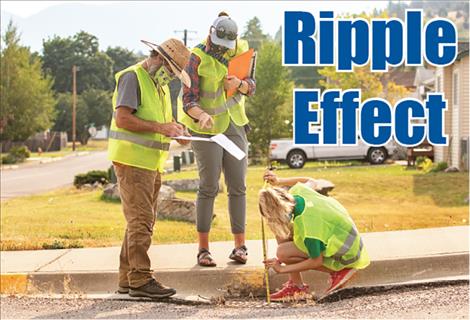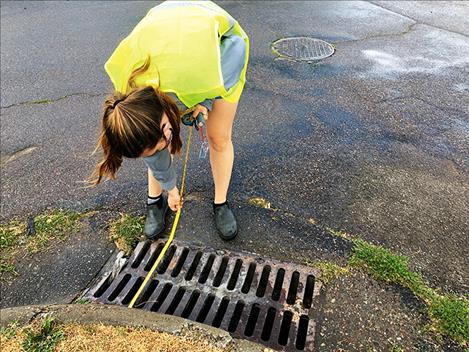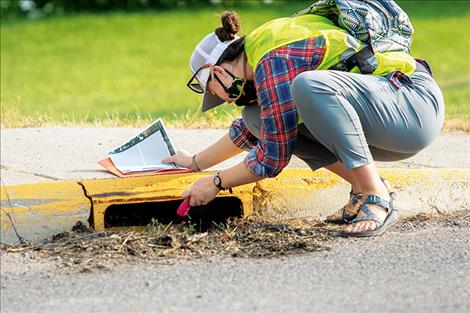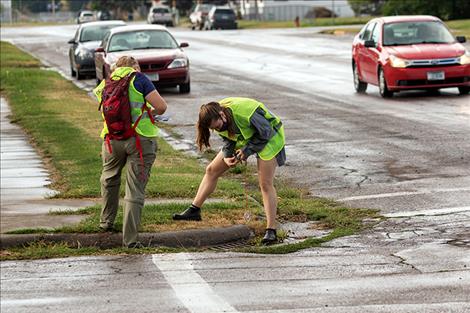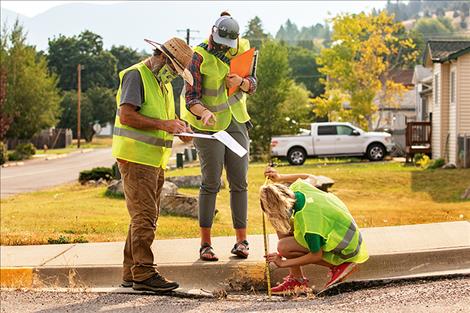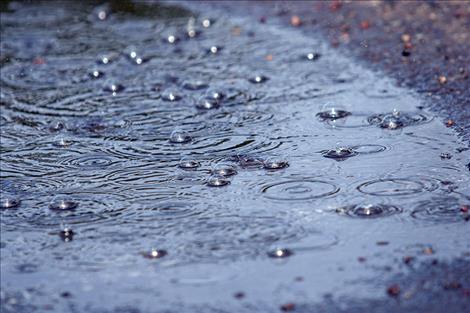Volunteers collect vital information to combat water pollution
Hey savvy news reader! Thanks for choosing local.
You are now reading
1 of 3 free articles.
POLSON — Armed with tape measures and aerial maps, a small army of volunteers wearing bright yellow safety vests took to the city streets of Polson last Thursday to help reduce the amount of pollutants entering Flathead Lake from stormwater runoff.
“The purpose of this project is to determine the locations and characteristics of important stormwater infrastructures throughout the City of Polson. This includes catch basins, stormwater manholes and outfalls,” explained event organizer and Big Sky Watershed Corps member Emilie Henry. “We care about the city’s stormwater infrastructure because once we understand more about it the more it will aid in the protection efforts of Flathead Lake from pollution.”
At Riverside Park, participants received some basic intel about stormwater and stormwater management before venturing out into different parts of the city. They learned that when water from rainfall and snowmelt is prevented from naturally filtering into the ground, the term stormwater is used by environmental regulators.
Stormwater is defined as any water from rain or snow that runs over hard, impervious surfaces like roads, driveways, parking lots and rooftops. It also has the ability to collect pollutants.
There are many types of pollutants that find their way into storm drains. Some common pollutants found in stormwater systems include used motor oil, fertilizers, soapy car wash water, anti-freeze, bacteria from pet waste, de-icing salts and excess sediment from construction project sites.
Many people incorrectly assume that all stormwater runoff will pass through a water treatment plant, ridding it of any and all potentially dangerous pollutants it may have picked up before entering waterways and wetlands. Stormwater systems were originally intended to route rainwater quickly off city streets during a heavy rainstorm or snowmelt with little to no treatment.
Working in two sessions, it took more than a dozen volunteers the better part of the day to measure, collect data and map the runoff flow of all the city-wide storm drain manholes, catch basins and outfalls.
According to Henry, it will take her a couple of weeks to sort through the collected information and digitize it so that it is in a useable and understandable format.
“I will share it with both the Flathead Basin Commission and the City of Polson,” Henry said. “My hope is that the City of Polson uses this information in its future building and development projects. It would also be great to see the city use this information to strategize where stormwater treatment facilities might be most effective for cleaning up stormwater before it enters the lake.”
Henry also explained that the FBC will use the information to figure out where samples should be collected for future water quality monitoring efforts. “For example, if one outfall is collecting runoff from a very large portion of the city, then we expect stormwater runoff at that outfall to contain a higher concentration of pollutants than runoff from an outfall that is draining from a very small portion of the city,” said Henry.
“We can then sample the water at that outfall, figure out what pollutants are present and their concentrations, and then, work on solutions that will help keep these pollutants out of the lake.”
Thursday’s event also afforded an opportunity to bring the issue of stormwater runoff pollution into the public’s consciousness.
“Stormwater runoff is a leading source of water pollution in Montana,” said Henry citing a 2019 report from the City of Missoula’s Stormwater Division. “While their statement refers to Montana as a whole and not just specific to Flathead Lake, I still think it illuminates the importance of this issue.”
Stormwater pollution prevention is not just a goal for municipalities or city utilities. It is also a community-wide responsibility. “The most important thing residents can do to prevent stormwater pollution is recognize that anything they leave on the landscape has the potential to end up in our water bodies through stormwater runoff,” said Henry. “Just recognizing this fact and being careful about what you put on the landscape is a great first step to minimizing pollution to Flathead Lake.”
Henry offered a few simple at-home prevention solutions to reduce unwanted stormwater runoff pollution. People should pick up after pets. Bacteria from animal waste can flow into water bodies and harm fish and other animals. While fixing fluid leaks or repairing a vehicle, use drip pans to catch engine oil, antifreeze and other fluids. Never dump anything down a storm drain. Used oil from a single oil change can pollute up to one million gallons of fresh water. The EPA estimates that American households improperly dump about 193 million gallons of used oil every year or roughly the equivalent of 17 Exxon Valdez oil spills.
Wash your car at a commercial car wash. If you wash your car at home, wash it on your lawn or unpaved surface rather than in the street or in your driveway so the excess water can be absorbed by the ground.
Avoid raking grass clippings, leaves and yard waste onto roads or sidewalks. Storm drains can easily get clogged by yard waste, causing infrastructure damage and flooding. Excess organic matter from leaves and grass can also lead to harmful high nutrient pollution levels and decreased oxygen in the streams, rivers and lakes.
People should reduce rooftop runoff by redirecting downspouts to vegetated areas, away from foundations, paved surfaces and the storm drain on your street. It is also important to minimize the use of herbicides, insecticides and fertilizers to keep contaminants out of stormwater. According to the U.S. Fish and Wildlife Service, homeowners use up to 10 times more chemical pesticides per acre on their yards than farmers use on their crops. People should keep the storm drains near homes and work clear of debris, leaves and trash.
The Flathead Basin Commission offers numerous resources to help in conservation efforts. Visit the FBC website at https://flatheadbasincommission.org/ for more information.















